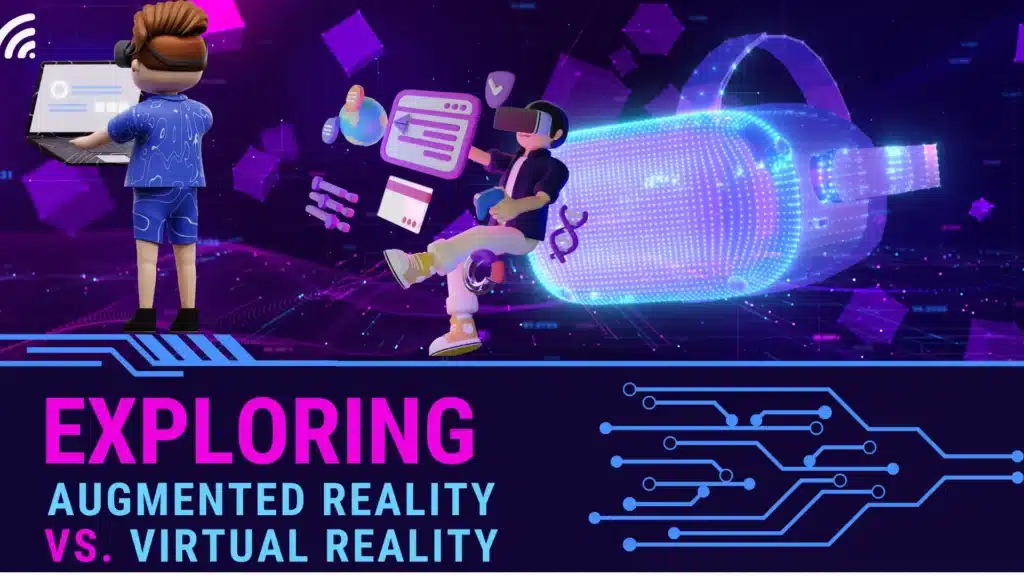In today’s advancing world, advances in technology are opening up new areas of knowledge and interactions. Augmented reality (AR) and virtual reality (VR) are two famous technologies that have received a lot of attention. These immersive technologies provide novel ways to see and interact with the digital environment. They open up new opportunities in a variety of sectors. In this article, APKShoot will look into the worlds of Augmented Reality vs Virtual Reality, understand the differences between them, explore the benefits they provide, and think about their future developments.
Understanding Augmented Reality (AR)
As the name implies, augmented reality improves our experience of reality by placing digital features on the actual environment. AR effortlessly incorporates virtual information, such as photographs, movies, or 3D models, into our immediate surroundings, resulting in an augmented experience.
This method superimposes computer-generated material over real-world environments. As a result, our perception and relationship with our immediate environment are improved. Users can encounter a hybrid of virtual and real-world features by using smartphones, tablets, smart glasses, or specialist AR devices. AR effortlessly integrates digital information into our surroundings, providing for a better comprehension of items, locations, or events.

How AR Works
AR delivers immersive experiences through a mix of technology and software. AR devices, such as smartphones, smart glasses, or headsets, can reliably monitor the user’s motions and place virtual items in real-time inside their field of vision by using cameras, sensors, and complex algorithms.
Applications of AR
AR applications cover several sectors, revolutionizing fields such as
- Gaming and Entertainment
- Retail and E-commerce
- Education and Training
- Healthcare
Understanding Virtual Reality (VR)
Virtual Reality offers an entirely immersive experience by transferring users into a simulated digital environment. Unlike AR, VR completely replaces the real world with a virtual environment. It generates a sensation of presence and allows users to interact with it.
In contrast, Virtual Reality (VR) immerses viewers in a wholly synthetic environment, replacing the actual world with a virtual one. Wearing a VR headset allows users to be transported to various virtual realms while remaining isolated from their physical environment. Users may explore, interact, and engage with digital surroundings in a completely immersive manner, activating many senses to generate a sensation of presence.
How VR Works
VR creates a virtual world by combining headgear, motion-tracking sensors, and controllers. The user wears a virtual reality headset, which shuts out the physical world and offers a digital environment via high-resolution screens and immersive sounds. Users may interact with the virtual world using motion-tracking sensors and controllers, which adds to the sensation of immersion.
Applications of VR
VR has made major advances in a variety of sectors and has found uses in
- Gaming and Entertainment
- Architecture and Design
- Training and Simulation
- Therapy and Rehabilitation
Augmented Reality vs Virtual Reality
While both AR and VR provide immersive experiences, they vary in a few significant ways:
Applications of AR
- Sensory Experience
AR augments the user’s perspective with additional information placed on top of the real environment. Visuals, sounds, or haptic feedback use to enhance the sensory experience. In contrast, virtual reality (VR) totally replaces the user’s sensory input with simulated settings, resulting in a more intense and concentrated sensory experience.
- Real vs. Virtual Environments
AR incorporates digital material into the user’s physical surroundings, improving their impression of reality. It establishes a connection with reality and provides instant communication. VR, on the other hand, produces a completely virtual environment that is disconnected from the actual world. VR allows users to explore and interact with a simulated reality free of real-world boundaries.
- User Interaction
AR allows users to interact with both real and virtual things in their environment. They may interact with virtual material, examine more information about actual items, and even collaborate in real-time with others. Interaction in VR takes place mostly within the virtual world. In VR users may handle things, explore virtual areas, and interact with computer-generated components.
Applications of AR
AR is used in a variety of sectors and areas, including
- Enhancing Real-World Interactions
Architecture, interior design, and construction have all been transformed by augmented reality technology. It enables experts to superimpose digital models on physical locations, allowing them to see and evaluate designs in real time. Furthermore, AR improves shopping experiences by offering virtual clothes try-ons and allowing buyers to see furniture layouts in their homes.
- Practical Applications
AR plays a critical role in boosting efficiency and accuracy in industries like as manufacturing and logistics. AR-enabled gadgets may be worn by workers to deliver real-time instructions and information, assisting them in complicated manufacturing processes or navigating them around warehouses. This technology is also used in maintenance and repair, allowing technicians to access digital instructions or remote support while working on complex equipment.
- Entertainment and Gaming
AR has completely changed the game scene, providing engaging and immersive experiences. Games like Pokémon Go popularised augmented reality by allowing users to capture virtual animals in the real world. AR-based escape rooms, treasure hunts, and instructional games have also grown in popularity, combining the digital and physical worlds for entertaining amusement.
| Augmented Reality (AR) | Virtual Reality (VR) | |
| 1. | Enhances the real world with virtual elements | Immerses users in a completely virtual world |
| 2. | Requires less hardware and computing power | Requires powerful hardware and processing |
| 3. | Users maintain awareness of their physical surroundings | Users are entirely cut off from the outside world. |
| 4. | Commonly used in mobile apps and wearable devices | Primarily used with dedicated VR headsets |
| 5. | Blends digital content with the real world | Creates a fully artificial digital environment |
| 6. | Often used for practical purposes, like navigation or remote assistance | Primarily used for gaming and simulations |
| 7. | Can be used for real-time data visualization | Offers immersive storytelling and experiences |
| 8. | Examples include AR filters, games, and educational tools | Examples include VR gaming, training simulations, and virtual tours |
| 9. | Relies on camera input to track and map the environment | Requires motion tracking and controllers for user interaction |
| 10. | Offers a more social experience, allowing users to interact with others in the real world | Offers solitary experiences, unless in a shared virtual environment |
| 11. | Digital content is anchored to real-world objects or locations | Users can freely navigate and interact within a virtual environment |
| 12. | Can be used for product visualization and virtual try-on | Users may engage with virtual items and surroundings by exploring and exploring them. |
| 13. | Provides contextual information in real-time | Provides the user with a sensation of presence and immersion. |
| 14. | Examples include Pokémon GO, Snapchat filters, and Google Maps AR | Oculus Rift, HTC Vive, and PlayStation VR are a few examples. |
| 15. | Provides a broader range of applications in areas such as retail, healthcare, and education. | Predominantly used in gaming, entertainment, and training sectors |

Applications of VR
VR, on the other hand, has its own set of benefits and applications:
- Immersive Simulations
VR offers unique capabilities for immersive simulations and virtual experiences. It has seen widespread use in industries including aviation and military training. Where realistic virtual environments enable trainees to practice complicated tasks in a safe and regulated environment. VR simulations can also help healthcare professionals with surgical training and patient diagnostics.
- Training and Education
VR gives up new options for immersive learning in the field of education. Students may travel through space, plunge into the depths of the ocean, and visit historical locations all from the comfort of their classrooms. VR experiences increase engagement and retention by making complicated subjects more approachable and participatory.
- Therapeutic Benefits
In therapeutic contexts, virtual reality has demonstrated promising outcomes. VR provides immersive environments for pain management, anxiety treatment, and phobia exposure therapy. VR can help people overcome their phobias, manage chronic pain, and undertake rehabilitation by generating realistic settings.
Future Trends and Integration
We should expect fascinating breakthroughs and more interaction with other technologies as AR and VR continue to mature. The combination of AR and VR, known as mixed reality (MR), has enormous promise. MR effortlessly merges the real and virtual worlds, allowing users to engage with digital material while remaining present in their physical environment.
Furthermore, advances in technology, such as smaller and higher-resolution headsets, will make AR and VR more accessible to a number of audiences. Merging with artificial intelligence (AI) and Internet of Things (IoT) technologies will expand AR and VR’s capabilities. There all factors allow smarter and more intuitive interactions.
Conclusion
Augmented reality (AR) and virtual reality (VR) have altered our perception and interaction with the digital world. AR enhances our real-world experiences by superimposing virtual components, whereas VR transfers us to completely immersive virtual realms. Both technologies offer distinct advantages and are used in a variety of sectors, ranging from improving real-world interactions to creating immersive simulations.
As AR and VR continue to progress, their integration with other technologies like AI also progresses. As technology becomes more accessible and advances these immersive technologies transform industry, education, entertainment, and even therapeutic practices.
Related Post
- Comprehensive Guide to Enhancing Health Potions in Diablo 4
- Unlock Exclusive Rewards with League of Legends Redeem Codes
- Amazon Prime Gaming: Unlocking the Best Gaming Experience
FAQ
No, they are different technologies. AR overlays virtual elements in the real world, while VR creates a fully virtual environment.
Yes, AR and VR can be combined to create mixed-reality experiences, where virtual and real-world elements coexist.
Gaming, education, healthcare, retail, entertainment, and training have all benefited significantly from AR and VR technologies.
While both technologies provide immersive experiences, AR overlays virtual material on top of the actual world, whereas VR provides an entirely simulated environment. They have several applications and use cases.
Popular AR applications include interactive gaming experiences like Pokémon Go, virtual try-on for fashion and cosmetics, AR navigation for exploring cities, and AR-enhanced educational tools.
Yes, there are constraints. AR requires a camera-equipped device, and the quality of the AR experience is determined by the device’s capabilities. VR can induce motion sickness in some people, and high-quality VR experiences sometimes need sophisticated gear.
Absolutely! AR and VR have various advantages for businesses. AR can enhance product visualization and remote collaboration, while VR can be used for training, virtual meetings, and product prototyping.










